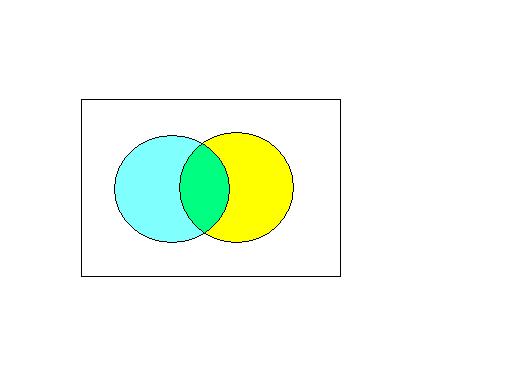Review Excercises for SETS <<< Back
1.2). Using Venn Diagrams verify each of the set Identities. (Text Book Excercises)
Some of the important from the 19 set identities are solved here and the
rest are left
for you.
Solution:
Note: Green color is the intersection
region for yellow and blue when using
yellow for one set and blue for other. When illustrating using three sets
red, blue, green are used for different sets and black is used for
the
intersection of all three.
i) A ![]() B = B
B = B ![]() A
A
The below shown are the individual sets A and B
Assuming that there are some elements which belong to and some elements
which belong
to B and some elements which belong to both A and B. Then A ![]() B is as shown below.
B is as shown below.

The whole of the region consisting of yellow, green and blue alltogether
is A ![]() B.
B.
Now let us do the same for B ![]() A.
A.

B ![]() A is the region consisting
of yellow, green and blue.
A is the region consisting
of yellow, green and blue.
As both A ![]() B and B
B and B ![]() A cover the same region shown by pink,
A cover the same region shown by pink,
we can conclude that
A ![]() B = B
B = B ![]() A
A
2) A ![]() ( A
( A ![]() B)
= A
B)
= A
First let us draw the Venn diagram of A ![]() B and then the complete Venn Diagram for
B and then the complete Venn Diagram for
A ![]() ( A
( A ![]() B)
B)
Venn Diagram for A ![]() B is shown below
B is shown below
Green color portion is the A ![]() B area.
B area.

Now let us draw the Venn Diagram for A ![]() ( A
( A ![]() B)
B)
From the above Venn Diagram it should be very clear that A ![]() ( A
( A ![]() B)
is A.
B)
is A.
According to the definition of Union, the area belonging to only
A
and area
belonging to only B and the area common for both A and B is the
area which
belongs to A ![]() B. So from the above Venn diagrams it is pretty clear that
B. So from the above Venn diagrams it is pretty clear that
the green portion showing A ![]() B is a part of A and so the answer is A itself.
B is a part of A and so the answer is A itself.
3)
(A ![]() B)' = A'
B)' = A' ![]() B'
B'
Let us complete the Venn Diagram for (A ![]() B)'. Then complete the Venn Diagram
B)'. Then complete the Venn Diagram
for A' ![]() B' and
compare to see if they both cover the same area of the Venn Diagrams,
B' and
compare to see if they both cover the same area of the Venn Diagrams,
if so the identity is proved.
As a first step, we will start with drawing Venn Diagram for (A ![]() B)'.
B)'.
(A ![]() B)' Venn Diagram is
shown below
B)' Venn Diagram is
shown below
fig. 1
Blue color area indicates (A ![]() B)'. It is the area belonging to U - (A
B)'. It is the area belonging to U - (A ![]() B).
B).
Now let us draw the Venn Diagram for A' and B' and then
their intersection.
Yellow region indicates the A' area and blue color indicates the B' area..

Fig. 2
B' is shown below.

Fig 3
The intersection of above two Venn Diagrams is nothing but the common area
covered by both the Venns. It is nothing but A' ![]() B' shown below
B' shown below
Fig. 4
A' ![]() B' area.
B' area.
By observing the area covered in both Fig.1 and Fig.4 we can say that both
(A ![]() B)' and
A'
B)' and
A' ![]() B' cover
the same area. So the identity is proved.
B' cover
the same area. So the identity is proved.
4)
A ![]() A' = Null
(empty set)
A' = Null
(empty set)
Set A and A' are shown in the following Venn Diagram.
The following is the Venn Diagram for A ![]() A'
A'

From fig.1 we can clearly see that there is nothin in common between A
and A'.
Intersection implies the elements common in both the sets. As the sets
have no
common elements(area) its an Empty Set or NULL set.